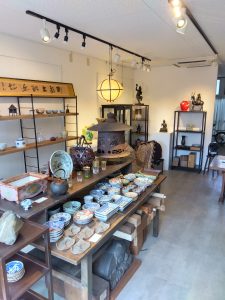月が綺麗に見える季節になってきました(愛知県名古屋市千種区姫池通 骨董買取 古美術風光舎)
2024.09.14
皆さまこんにちは。スタッフTでございます。

昨日は、スタッフHのブログを読んで、複雑な気持ちで空を見上げたのですが、複雑な気持ちとは裏腹に、上弦(半月)は過ぎましたが、月はくっきりと美しく見えました。ですが、くっきり見える月を見ても、本当に季節は秋に移っているのか?と思えるほどの日中の暑さです。
秋の月がなぜきれいに見えるのかというと、空気中の水蒸気量に関係します。秋は1年の中で水蒸気量が少ない時期なので、月がぼやけずにくっきりはっきりと見えるというわけです。反対に春は空気中のちりや花粉などが多く、月がぼやけて見えることもあります。
また秋は月の高度が高すぎず低すぎずちょうど良い位置にあるのも理由の1つです。夏や冬は高すぎたり低すぎたりして、きれいに見るのは難しい季節なのです。
そもそも月は自ら光っているわけではなく、太陽の光を反射することで輝いて見えている訳ですが、太陽の光が当たっている半球が地球から見てどちらを向いているかによって、三日月や上弦、満月、下弦など、見かけ上の形が変わります。満月、三日月は分かりますが、上弦・下弦の月はどっちがどっちだったか分からなくなるのは私だけでしょうか。
その定義によれば、「月から見た太陽の方向を基準に、黄経差が0度の瞬間が朔(新月)、90度の瞬間が上弦(半月)、180度の瞬間が望(満月)、270度の瞬間が下弦(半月)」とされているとのことですが、簡単に言うと、私たちから見て「右側」に月が見える時は「上弦」、「左側」に見える時が「下弦」ということでしょうか。あまり役には立たない知識な気がしますが、子供たちも授業で習うので、聞かれた時は自信満々に答えるチャンスですよ。
そもそも上弦や下弦の「弦」とは、弓に張る糸、つまり弦(つる)のことで、半月の形が弓に似ていることから、弓の真っ直ぐな部分である「弦」の漢字が用いられたと言われています。
そして上弦と下弦の名前の由来は諸説ありますが、有名なものは下記の2つです。
1つ目は、新月を含む日を1日とし、月の満ち欠けで1か月を定める太陰暦を使っていた時代に、月の前半(上旬)の月を上弦、月の後半(下旬)の月を下弦と呼んだというもの。
2つ目は、西の地平線に沈む時に、弦(半月の真っ直ぐな所)が上に位置しているか、下に位置しているかでどうかでつけられたというもの。
上弦は直線部が上で、半円部が下の状態で沈んでいきます。このため弦の部分が上で沈む月を上弦、弦の部分が下で沈む月を下弦と呼んだというものです。
日本では月を鑑賞するという風習は古くから見られますが、二十四節気や和風月明と同じで、毎晩見える月にそれぞれ呼び名をつけています。十五夜の翌晩から順に、十六夜(いざよい)月、立ち待ち月、居待ち月、寝待ち月と呼びます。立ち待ち月、居待ち月、寝待ち月は、名月の後に見える月は、出てくるのが遅く感じられたことから、「立って待つ月」「座って待つ月」という意味を持つ名前が付けられたそうです。
中秋の名月まであと少し。「月」というと、うさぎが餅つきをしている様子を思い浮かべるというのは昭和世代ならお決まりですが、私には月を見てどこがうさぎの餅つきなのか分かりません(笑)
子供が小さい頃、「どうして月にうさぎがいるの?どうしてお餅をついているの?」と聞かれ、「たぶんお餅が好きだからじゃない?」と困った挙句、親として面目丸つぶれの回答をしたことを思い出しました。
令和の子どもたちには何に見えるでしょうか?世界では「カニ」「ロバ」「本を読むおばあさん」などに見えるそうですが、皆さまはどう見えますか?
ではでは、また。
Hello everyone. This is Staff T.
Yesterday, I looked up at the sky with mixed feelings after reading Staff H’s blog. Despite my mixed feelings, the moon looked clear and beautiful, although the sangen (half moon) has passed. However, despite the clear moon, it was so hot during the day that I wondered if the season had really moved into autumn. It is so hot during the daytime that it seems as if the season has really moved into autumn.
The reason why the moon looks so beautiful in autumn has to do with the amount of water vapor in the air. Since the amount of water vapor is low in autumn, the moon appears clear and bright without being blurred. Conversely, in spring, there is more dust and pollen in the air, and the moon may appear blurred.
Another reason is that the moon’s altitude is not too high or too low in autumn. In summer and winter, it is too high or too low, making it difficult to see the moon clearly.
The moon does not shine by itself, but shines by reflecting the sun’s light. The apparent shape of the moon changes depending on which way the sunlit hemisphere faces from the earth, such as crescent, waxing, full, or waning. I can understand full and crescent moons, but am I the only one who can’t tell which was which for the upper and lower sine moons?
According to the definition, the moment when the difference of ecliptic longitude is 0 degrees from the direction of the sun as seen from the moon is the Saku (new moon), 90 degrees is the Jogetsu (half moon), 180 degrees is the Mo (full moon), and 270 degrees is the Shimogetsu (half moon). I guess this means that when the moon is seen on the “left side” from our point of view, it is “lower sine”. I feel that this knowledge is not very useful, but children learn it in class, so it is a good chance to answer confidently when they are asked.
To begin with, the “string” in Jogen and Shimogen refers to the string, or vine, that is stretched over the bow, and it is said that the kanji for “string,” the straight part of the bow, was used because the shape of the half-moon resembles a bow.
And although there are various theories about the origin of the names Sangen and Shimogen, the two most famous ones are as follows.
The first is that in the days when the lunar calendar was used to determine a month by the phases of the moon, with one day including the new moon, the first half of the month (early) was called Sangen and the second half of the month (late) was called Shimogeng.
The second is that the name was given according to whether the string (the straight part of the half-moon) was positioned above or below the moon when it set on the western horizon.
The upper sine sets with the straight part of the string above and the semicircular part below. For this reason, the moon with the string part setting above is called Sangen, and the moon with the string part setting below is called Shimogigen.
In Japan, the custom of appreciating the moon has been observed since ancient times, and as with the 24 solar terms and Japanese moonlight, each night’s visible moon is given a name. Starting from the night after Jugoya (the night of the fifteenth day of the eleventh month), the moons of the sixteenth, sixteenth, eighteenth, eighteenth, and nakayatsuzuki are called, in that order. The names “tachi-no-waiting moon,” “居待ち月,” and “ne-no-waiting moon” mean “standing moon” and “sitting moon,” respectively, because the moon seen after the “famous moon” seemed to be slow in coming out.
We are just a few days away from the Mid-Autumn Moon. The word “Tsuki” conjures up images of rabbits pounding rice cakes, which is a common sight for the Showa generation, but I don’t know what part of the moon is a rabbit pounding rice cakes (laugh).
When my children were young, they would ask me, “Why is there a rabbit on the moon? Why are they making rice cakes?” I was troubled, and then I asked myself, “Maybe because it likes rice cakes. I remember that I was embarrassed, and then I answered, “Probably because I like rice cakes.
What do you think they look like to children in 2021? I heard that in other parts of the world, they look like a crab, a donkey, an old lady reading a book, etc. What do you see?
See you soon.
*******************
ご実家の整理やお片付けなどをされている方のご相談などが多くございます。
お片付けなどくれぐれもご無理のないようになさってくださいませ。
風光舎では古美術品や骨董品の他にも絵画や宝石、趣味のお品など様々なジャンルのものを買受しております。
お片付けをされていて、こういうものでもいいのかしらと迷われているものでも、どうぞお気軽にご相談下さいませ。
また風光舎は、出張買取も強化しております。ご近所はもちろん、愛知県内、岐阜県、三重県その他の県へも出張いたします。
なお、毎月21日の持込鑑定会では無料鑑定・買取・ご相談など、ご予約なしで承っております。
ご近所の皆さま、ご遠方のみなさまも、お気軽にお越しくださいませ。
まずは、お電話お待ちしております。
愛知県名古屋市千種区姫池通
骨董 買取【古美術 風光舎 名古屋店】
TEL052(734)8444
10:00-18:00 OPEN
#出張買取#骨董#古美術#骨董品#絵画#版画#茶道具#刀剣#彫刻

